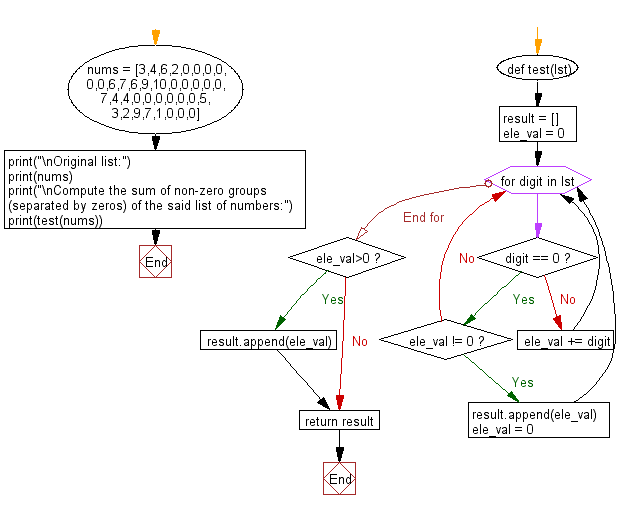Python: Compute the sum of non-zero groups (separated by zeros) of a given list of numbers
Python List: Exercise - 210 with Solution
Write a Python program to compute the sum of non-zero groups (separated by zeros) of a given list of numbers.
Sample Solution:
Python Code:
def test(lst):
result = []
ele_val = 0
for digit in lst:
if digit == 0:
if ele_val != 0:
result.append(ele_val)
ele_val = 0
else:
ele_val += digit
if ele_val>0:
result.append(ele_val)
return result
nums = [3,4,6,2,0,0,0,0,0,0,6,7,6,9,10,0,0,0,0,0,7,4,4,0,0,0,0,0,0,5,3,2,9,7,1,0,0,0]
print("\nOriginal list:")
print(nums)
print("\nCompute the sum of non-zero groups (separated by zeros) of the said list of numbers:")
print(test(nums))
Sample Output:
Original list: [3, 4, 6, 2, 0, 0, 0, 0, 0, 0, 6, 7, 6, 9, 10, 0, 0, 0, 0, 0, 7, 4, 4, 0, 0, 0, 0, 0, 0, 5, 3, 2, 9, 7, 1, 0, 0, 0] Compute the sum of non-zero groups (separated by zeros) of the said list of numbers: [15, 38, 15, 27]
Flowchart:

Visualize Python code execution:
The following tool visualize what the computer is doing step-by-step as it executes the said program:
Python Code Editor:
Have another way to solve this solution? Contribute your code (and comments) through Disqus.
Previous: Write a Python program to count the number of groups of non-zero numbers separated by zeros of a given list of numbers.
Next: Write a Python program to remove an element from a given list.
What is the difficulty level of this exercise?
Test your Programming skills with w3resource's quiz.
Python: Tips of the Day
Find current directory and file's directory:
To get the full path to the directory a Python file is contained in, write this in that file:
import os dir_path = os.path.dirname(os.path.realpath(__file__))
(Note that the incantation above won't work if you've already used os.chdir() to change your current working directory, since the value of the __file__ constant is relative to the current working directory and is not changed by an os.chdir() call.)
To get the current working directory use
import os cwd = os.getcwd()
Documentation references for the modules, constants and functions used above:
- The os and os.path modules.
- The __file__ constant
- os.path.realpath(path) (returns "the canonical path of the specified filename, eliminating any symbolic links encountered in the path")
- os.path.dirname(path) (returns "the directory name of pathname path")
- os.getcwd() (returns "a string representing the current working directory")
- os.chdir(path) ("change the current working directory to path")
Ref: https://bit.ly/3fy0R6m
- New Content published on w3resource:
- HTML-CSS Practical: Exercises, Practice, Solution
- Java Regular Expression: Exercises, Practice, Solution
- Scala Programming Exercises, Practice, Solution
- Python Itertools exercises
- Python Numpy exercises
- Python GeoPy Package exercises
- Python Pandas exercises
- Python nltk exercises
- Python BeautifulSoup exercises
- Form Template
- Composer - PHP Package Manager
- PHPUnit - PHP Testing
- Laravel - PHP Framework
- Angular - JavaScript Framework
- Vue - JavaScript Framework
- Jest - JavaScript Testing Framework
